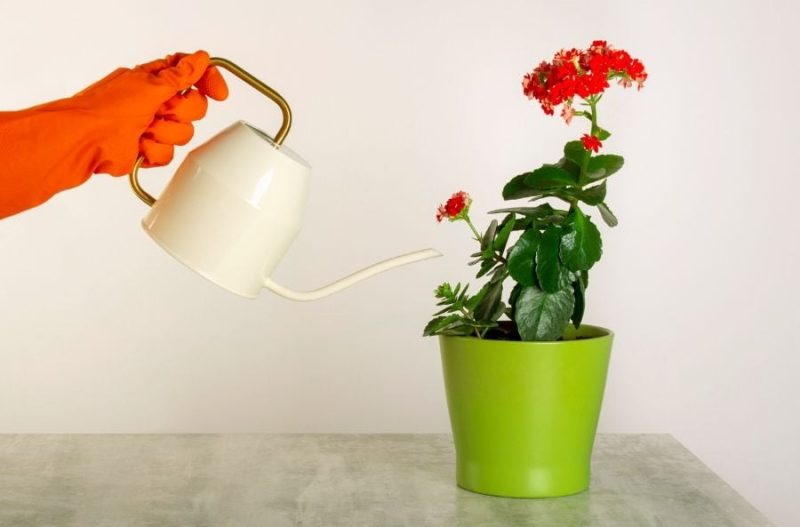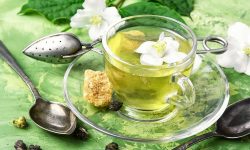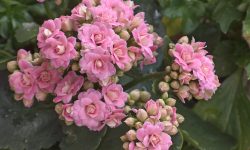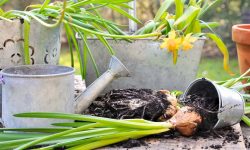Kalanchoe is one of the most popular indoor succulents because of its colorful flowers and easy care. Its thick, fleshy leaves store water, making it a drought-tolerant plant that thrives with minimal attention. However, many gardeners struggle to find the right watering balance. Too little water can cause drooping and dry leaves, while too much leads to root rot and faded blooms. Understanding the correct watering schedule is key to keeping your Kalanchoe vibrant and full of life.
This guide explains exactly how often to water Kalanchoe based on its growing conditions, seasons, and environment. You will learn how soil, light, humidity, and pot type influence watering needs. We’ll also cover how to recognize signs of overwatering and underwatering, plus expert tips to maintain healthy, long-lasting blooms. With the right watering routine, your Kalanchoe will reward you with strong leaves, bright flowers, and consistent growth all year.
Understanding Kalanchoe’s Watering Needs

Kalanchoe is a succulent, meaning it stores water in its thick leaves and stems. This adaptation allows the plant to survive in dry conditions where moisture is scarce. Because of this, Kalanchoe does not need frequent watering like many other houseplants. Its roots prefer a dry environment between waterings. The key to keeping it healthy is allowing the soil to dry out completely before watering again. A good rule is to water thoroughly, then wait until the top half of the soil feels dry to the touch. This rhythm prevents excess moisture that can damage the roots.
Watering needs also depend on the growing environment. In bright, warm rooms, the soil dries faster, and the plant may need water every 7 to 10 days. In cooler or shaded areas, the intervals can extend to two or even three weeks. The season also plays a major role. During active growth in spring and summer, Kalanchoe uses more water, while in fall and winter, it enters a resting phase and needs less. Adjusting your watering routine to these cycles keeps the plant balanced and thriving.
Understanding how your Kalanchoe reacts to moisture is the best guide. The leaves provide clear signals about its hydration level. Firm, plump leaves indicate proper watering, while soft, wrinkled ones show dehydration. Mushy or yellow leaves, on the other hand, suggest overwatering. Observing these signs regularly helps you fine-tune your routine. Once you learn how to read your plant, watering becomes simple and natural. With time, you’ll know exactly when it’s thirsty and when to wait, creating the ideal balance for lasting blooms and healthy growth.
Factors That Affect How Often to Water Kalanchoe
Light and Temperature
Light and temperature directly influence how fast your Kalanchoe absorbs and loses moisture. When placed in bright, indirect sunlight, the plant grows actively and uses more water to support photosynthesis and new leaf development. In this condition, watering every 7 to 10 days is usually enough, depending on room temperature and airflow. On the other hand, plants kept in shaded or cooler areas will dry out more slowly, so they need watering less often—typically every two to three weeks. Observing how quickly the top layer of soil dries is the best way to determine the right timing for your environment.
Seasonal changes also affect watering frequency. During spring and summer, when light intensity and temperatures are higher, Kalanchoe consumes more moisture to sustain active growth. In autumn and winter, the plant enters a resting phase, meaning its water needs drop significantly. Overwatering during this time is a common mistake that leads to root rot. Try to maintain moderate indoor temperatures between 60°F and 75°F, avoiding sudden drops or direct heat sources. By monitoring light and temperature, you can create an ideal balance that keeps your Kalanchoe hydrated without overwatering.
Pot Type and Soil Quality
The pot and soil you choose determine how efficiently your Kalanchoe’s roots manage moisture. Terracotta pots are often the best choice because they are porous and allow air circulation, helping the soil dry evenly after watering. This prevents water from sitting at the bottom and suffocating the roots. Plastic and glazed ceramic pots, while decorative, retain more moisture, so you should water less often. Always check that your pot has drainage holes to allow excess water to escape easily.
Soil quality plays an equally important role. Kalanchoe thrives in light, fast-draining soil, such as a cactus or succulent mix. Adding sand, perlite, or pumice to regular potting soil can improve drainage and aeration. Dense, compact soil retains water for too long and promotes fungal diseases or root decay. Replacing the soil every one to two years also helps maintain nutrient balance and prevents compaction. By using the right combination of breathable pots and airy soil, you create an environment that encourages healthy root systems and steady, controlled moisture levels for your Kalanchoe.
How to Water Kalanchoe the Right Way
Watering Kalanchoe properly is all about technique and timing. The best method is to water deeply and less frequently. Pour water slowly into the soil until it starts to drain from the bottom of the pot. This ensures that the entire root system receives moisture. Once the excess water drains out, discard any remaining liquid from the saucer. Never let the pot sit in standing water, as this suffocates the roots and encourages rot. After watering, wait until the top half of the soil dries completely before watering again. Touching the soil with your finger or using a moisture meter helps you determine when it’s time for the next watering. This simple routine mimics the natural wet-and-dry cycle Kalanchoe experiences in the wild.
The temperature and environment in your home also affect the watering process. In warm rooms with plenty of sunlight, the soil dries faster, meaning you’ll need to water more often. During winter, when temperatures drop and light levels are lower, watering once every two to three weeks is usually enough. Be cautious during this period, as overwatering is the most common cause of problems. If the leaves start looking soft, mushy, or pale, it’s a sign that the roots are sitting in too much water. Conversely, wrinkled and droopy leaves mean the plant is too dry. Learning to recognize these signs ensures you water only when necessary.
Another important aspect is water quality. Kalanchoe prefers soft, room-temperature water free from chemicals. Tap water high in chlorine or minerals can damage roots over time, so letting it sit overnight before use allows harmful substances to dissipate. Filtered or rainwater is ideal if available. Watering in the morning gives the plant time to absorb moisture before temperatures rise, preventing fungal growth and ensuring healthier blooms. Consistency and observation are the keys to mastering Kalanchoe watering and keeping your plant strong and full of life.
Seasonal Watering Guide for Kalanchoe
Spring and Summer
Spring and summer are Kalanchoe’s active growing seasons, meaning the plant needs more frequent watering to support new leaf and flower development. As temperatures rise and sunlight increases, the soil dries out faster. During this period, water your Kalanchoe once every 7 to 10 days, depending on humidity and pot size. Always check the soil before watering—it should feel dry halfway down. Deep watering ensures the roots receive enough moisture without leaving the soil soggy. Regular feeding with diluted fertilizer every two to three weeks during this time also helps maintain lush growth and vibrant blooms.
These warmer months also bring faster evaporation, so monitor your plant’s condition closely. If you notice leaves starting to wrinkle or the flowers fading early, it’s a sign the plant needs slightly more water. Avoid watering too often, though, as saturated soil can quickly lead to root rot. Instead, focus on consistency and timing—watering early in the morning is best. Keep your Kalanchoe in bright, indirect light and maintain temperatures between 65°F and 80°F for optimal health. Proper watering in these months encourages steady flowering and strong, resilient foliage.
Fall and Winter
In fall and winter, Kalanchoe enters a resting phase, meaning its water needs drop significantly. The plant slows its growth, stores energy in its leaves, and prepares for the next bloom cycle. During this time, water only once every two to three weeks or whenever the soil feels completely dry. Overwatering during dormancy is one of the biggest mistakes gardeners make, as cooler temperatures slow evaporation. Always ensure the pot has good drainage and avoid letting water sit in the saucer. Less frequent watering helps prevent root decay and keeps the plant’s internal balance stable.
While the plant is resting, place it in a bright location but away from direct sunlight or cold drafts. Maintain indoor temperatures between 60°F and 70°F for best results. If the air in your home is dry from heating systems, you can lightly mist the area around the plant—not the leaves themselves—to add gentle humidity. Resume regular watering only when new growth appears in late winter or early spring. Understanding this seasonal shift prevents water-related stress and helps your Kalanchoe stay healthy, strong, and ready to bloom again in the coming months.
Signs of Overwatering and Underwatering
Kalanchoe plants are sensitive to their watering conditions, and they quickly show signs when something is wrong. Overwatering is the most common mistake, especially for indoor plants. When roots remain in waterlogged soil for too long, they begin to suffocate and rot. The leaves then turn soft, mushy, and sometimes yellow or translucent. In severe cases, they may fall off easily at the slightest touch. The base of the stem can also darken and become soft, a clear sign of root damage. You may notice a musty smell from the soil, indicating decay. When this happens, stop watering immediately, remove the plant from the pot, and cut off all rotted roots. Repot it in fresh, dry, well-draining soil and keep it in bright, indirect sunlight to recover.
Underwatering creates a different set of problems. When the soil stays dry for too long, Kalanchoe’s leaves begin to wrinkle and curl inward. The plant’s once-firm foliage becomes limp, dull, and dehydrated. Flowers fade quickly, and the overall appearance becomes weak and droopy. Although Kalanchoe tolerates dry conditions better than wet ones, it still needs regular watering during active growth. When you notice signs of dehydration, water thoroughly until moisture drains from the bottom, then allow the soil to dry again before the next watering. Within a few days, you’ll see the leaves regain their plump, healthy look.
Maintaining balance between these two extremes is essential. Always check the soil before watering—if it feels damp, wait a few more days. During warmer months, the plant will need more frequent watering, while in cooler months, much less. Good air circulation and a proper potting mix also help regulate soil moisture. By observing your plant and adjusting accordingly, you can prevent overwatering and underwatering, ensuring your Kalanchoe stays vibrant, healthy, and full of long-lasting blooms.
Best Watering Practices for Indoor and Outdoor Kalanchoe
Watering Kalanchoe indoors requires careful attention to environment and drainage. Indoor conditions often dry out slower than outdoors, so it’s essential to let the soil breathe between watering sessions. Always check the top two inches of soil before watering. If it feels dry, water deeply until excess drains from the bottom of the pot. Never leave the plant sitting in standing water. For indoor plants, watering every 10 to 14 days is usually ideal, though it depends on room temperature and light levels. Kalanchoe grown near bright windows may dry faster than those kept in cooler, shaded rooms. Remember that indoor humidity affects how quickly the soil dries—higher humidity means less frequent watering. A consistent routine and proper drainage prevent root problems and promote healthy blooms.
Outdoor Kalanchoe plants experience faster evaporation, especially in warm, sunny climates. They generally need more frequent watering, often every 5 to 7 days during summer. However, always adjust based on rainfall, temperature, and soil type. In dry regions or during heat waves, you may need to water more often to prevent leaf wilting. Morning watering works best, giving the soil time to absorb moisture before heat increases evaporation. During rainy or cooler periods, reduce watering to prevent waterlogging. If grown in garden beds, ensure the soil drains well and does not stay soggy after rain. Proper spacing between plants improves air circulation and keeps moisture levels balanced.
Whether indoors or outdoors, consistency is key to success. Use room-temperature water to avoid shocking the roots. Try to water at the base of the plant rather than on the leaves to prevent fungal issues. It’s better to slightly underwater than to overwater, as Kalanchoe stores moisture in its leaves. Observing seasonal and environmental changes ensures your watering routine stays effective. With balanced care, both indoor and outdoor Kalanchoe will flourish, producing lush leaves and vibrant flowers year after year.
Common Watering Mistakes to Avoid
Overwatering and Poor Drainage
Overwatering is the most common mistake when caring for Kalanchoe. Because this plant stores moisture in its leaves, it doesn’t need frequent watering like other houseplants. When the soil stays wet for too long, the roots suffocate, leading to rot and fungal infections. The first signs appear as yellowing leaves, soft stems, and a musty odor from the soil. To avoid this, always let the top half of the soil dry completely before watering again. Use a pot with drainage holes to release excess water and prevent moisture buildup. Terracotta pots work best because they help the soil dry evenly and allow better airflow around the roots.
Poor drainage often makes overwatering worse. Heavy, compacted soil traps water, keeping the roots wet for days. To fix this, use a light, well-draining mix made for succulents or cacti. Adding sand, perlite, or small gravel improves air circulation and drainage. Avoid using decorative pots without holes, as water can collect unnoticed at the bottom. Checking soil moisture before watering helps prevent soggy conditions. Consistent observation and proper drainage are the best ways to protect your Kalanchoe from overwatering stress and ensure strong, healthy root growth.
Inconsistent Watering Routine
Another common mistake is watering on an irregular schedule. Some gardeners water too often out of habit, while others forget for weeks. Kalanchoe prefers consistency—alternating between overwatering and drought can confuse the plant’s natural rhythm. Sudden changes cause leaf drop, weak stems, and reduced flowering. Instead of sticking to a fixed schedule, water based on your plant’s needs and environment. Feel the soil before watering; if it’s still damp, wait a few more days. In warm, bright rooms, you’ll likely need to water weekly, while in cooler seasons, every two to three weeks is enough.
Timing also plays a key role. Watering in the early morning allows the plant to absorb moisture before heat increases evaporation. Avoid watering late at night, as damp soil and cool temperatures create ideal conditions for rot. Keeping a steady routine helps the roots grow evenly and prevents stress-related problems. Once you learn how quickly your Kalanchoe’s soil dries, maintaining a natural rhythm becomes easy. A stable watering habit ensures long-lasting blooms and keeps the plant vibrant all year.
The Role of Humidity and Air Circulation in Watering
Humidity and air circulation directly influence how Kalanchoe absorbs and retains moisture. While many tropical plants prefer high humidity, Kalanchoe thrives in moderate or even slightly dry air. The ideal humidity range is between 40% and 50%. When humidity is too high, especially in poorly ventilated spaces, the soil takes longer to dry, increasing the risk of root rot and fungal growth. Conversely, extremely dry air can cause leaves to wrinkle and flower buds to dry out before opening. To maintain balance, keep your Kalanchoe in a room with steady airflow and away from humidifiers or bathrooms. If your indoor air is very dry during winter, place a shallow tray of water nearby to slightly raise humidity without overdoing it.
Proper air circulation is equally important for preventing watering issues. Good airflow helps moisture evaporate evenly from the soil, reducing the risk of mold and mildew. Stagnant air often causes damp spots around the plant’s base, especially after watering. Position your Kalanchoe near a window or in a space with natural movement of air, but avoid direct drafts from fans or air conditioners. Gentle ventilation allows the soil to dry consistently, ensuring the roots stay healthy and oxygenated.
Combining balanced humidity with steady airflow creates ideal growing conditions for Kalanchoe. The leaves will stay firm, and the flowers will last longer without showing signs of stress. These environmental factors also help regulate how often you need to water. In humid environments, you’ll water less frequently; in dry areas, slightly more. Monitoring both air and soil ensures the plant stays hydrated but never waterlogged. When humidity and air circulation are properly maintained, your Kalanchoe will reward you with vibrant blooms and lush, glossy foliage throughout the year.
Watering Kalanchoe After Blooming
After the blooming period ends, your Kalanchoe enters a rest phase that is just as important as the flowering stage. During this time, the plant slows its growth and begins storing energy in its leaves and stems for the next bloom cycle. Watering should also slow down to match this reduced activity. Continue watering only when the top half of the soil feels dry to the touch, usually every two to three weeks depending on temperature and humidity. Overwatering during this stage can lead to root rot since the plant uses less moisture. Always drain excess water from the saucer after watering to prevent standing water. This period of reduced watering helps the roots rest and strengthens the plant for future growth.
As the plant transitions into dormancy, you may notice some fading or shedding of older leaves. This is natural and should not cause concern. Avoid feeding or repotting during this stage, as Kalanchoe is conserving energy rather than producing new flowers. Keep it in a bright area with indirect light and stable temperatures between 60°F and 70°F. These gentle conditions encourage recovery without stressing the plant. If the air is very dry, maintain light humidity nearby, but never mist the leaves directly, as this can promote disease.
When you begin to see new leaf growth, it signals that your Kalanchoe is waking up from dormancy. At this point, you can gradually increase watering and resume light fertilizing to stimulate healthy development. Returning to a regular watering schedule too early can shock the plant, so always wait for visible signs of new growth. By understanding and respecting this post-bloom rest phase, you ensure a stronger, more vibrant plant that will bloom even more beautifully in the next cycle.
Choosing the Right Water and Tools for Kalanchoe
The quality of water you use for your Kalanchoe can greatly affect its overall health and blooming performance. Tap water that contains high levels of chlorine, fluoride, or minerals may cause leaf tip burn and weaken the plant’s root system over time. If your tap water is hard, let it sit overnight to allow chlorine to evaporate before watering. This simple step helps reduce chemical buildup in the soil. Using filtered or rainwater is even better, as it provides a gentler and more natural moisture source. Always use room-temperature water because cold water can shock the roots, while hot water may damage them. Consistent use of clean, balanced water ensures steady growth and prevents nutrient absorption problems.
The tools you use to water Kalanchoe also play a role in maintaining proper hydration. A watering can with a narrow spout gives you better control, allowing you to target the soil directly without wetting the leaves. Wet leaves can lead to fungal issues, especially in humid conditions. Avoid spraying water from above, as moisture can collect between leaves and cause rot. If your plant is in a small pot, pour water slowly until it drains from the bottom, ensuring even saturation. For larger containers, use a bottom-watering method—place the pot in a shallow tray of water for about 10 minutes so the roots absorb moisture naturally.
Caring for your tools is just as important as using them correctly. Clean your watering can regularly to prevent bacteria or mineral buildup. Use soft, non-metal containers to avoid rust contamination. Over time, these small details make a big difference in keeping your Kalanchoe healthy and blooming beautifully. By choosing pure water and proper tools, you protect the plant’s roots, maintain soil balance, and create the perfect foundation for consistent, colorful flowering throughout the year.
How Pot Size and Repotting Affect Watering Needs
Pot size has a major influence on how often you need to water your Kalanchoe. A pot that is too large retains water for longer periods, making it easier for the soil to stay soggy and cause root rot. A smaller pot, on the other hand, dries out faster and requires more frequent watering. The ideal pot is one that gives the roots enough room to grow but still allows the soil to dry evenly between waterings. Generally, choose a pot that is only one to two inches wider than the plant’s root ball. Always make sure it has drainage holes at the bottom to release excess moisture. The material of the pot also matters—terracotta dries quickly, while plastic or glazed ceramic retains more water, requiring careful monitoring. Finding the right balance between size, material, and drainage ensures your plant gets consistent hydration without becoming waterlogged.
Repotting also affects how your Kalanchoe absorbs and retains water. The best time to repot is after the blooming season or during early spring, when the plant begins active growth again. Use fresh, well-draining soil designed for succulents, ideally a mix of potting soil, sand, and perlite. This combination provides airflow around the roots and prevents compaction, allowing water to flow freely. After repotting, water the plant lightly and let it settle for a week before resuming regular watering. Avoid heavy watering right after repotting, as the roots need time to adjust and heal from any disturbance.
Over time, old soil can become compacted and lose its ability to drain effectively, leading to inconsistent watering. Refreshing the soil every one to two years helps maintain good structure and nutrient balance. Regular repotting also prevents the plant from becoming root-bound, which can reduce water absorption and stunt growth. By choosing the right pot size and repotting at the right time, you ensure your Kalanchoe maintains a stable moisture rhythm—neither too wet nor too dry—and continues to bloom with vigor and color year after year.
Watering Mistakes During Propagation and Growth
Watering mistakes are common during Kalanchoe propagation, as young plants have different moisture needs than mature ones. When propagating from leaf or stem cuttings, many gardeners make the mistake of watering too soon or too much. Fresh cuttings need time to form roots before they can absorb water properly. If the soil is kept too wet, the cuttings may rot before roots develop. The best approach is to let the cuttings dry for a day or two after planting to allow calluses to form, then mist the soil lightly every few days. The soil should stay barely moist, not wet. Once roots appear, you can begin a gentle watering schedule—just enough to keep the surface slightly damp. Overwatering at this stage is the fastest way to kill new growth. Patience is essential, as Kalanchoe cuttings root best in warm, well-lit conditions with minimal interference.
As the young plants establish themselves, their watering needs increase slightly. However, many growers continue misting rather than transitioning to deeper watering. This prevents the roots from growing downward and makes the plant weak. Once the roots are strong enough, start watering more thoroughly but less often. Allow the soil to dry completely between each watering session to encourage deep root growth. Overhead watering should also be avoided, as it can cause fungal problems in dense clusters of young plants. Watering from the base is safer and helps maintain clean, dry leaves.
During the early growth phase, consistency is key. Too much or too little water can stunt development and lead to soft, weak stems. Monitor the plant’s progress by checking leaf firmness and color—plump, green leaves indicate the right balance. Once the plant reaches maturity, transition to a regular watering routine similar to that of adult Kalanchoe. By adjusting your technique as the plant grows, you’ll build a stronger foundation for long-term health, vibrant foliage, and abundant flowering.
FAQs About Watering Kalanchoe
How often should I water my Kalanchoe?
Water your Kalanchoe every 7 to 10 days in spring and summer when it’s actively growing. In cooler months, water only every two to three weeks. Always check that the top half of the soil is dry before watering again to avoid overwatering and root rot.
Can I use tap water for Kalanchoe?
Yes, you can, but it’s best to let tap water sit overnight to remove chlorine and fluoride. Filtered or rainwater is ideal since it’s softer and prevents mineral buildup in the soil. Always use room-temperature water to protect roots from temperature shock.
What are the signs of overwatering?
Overwatered Kalanchoe shows soft, mushy, or yellowing leaves and a foul odor from the soil. The plant may appear droopy even though the soil is wet. To fix this, remove it from the pot, trim rotted roots, and replant in dry, well-draining soil.
How do I know if my Kalanchoe needs water?
When the top two inches of soil feel dry and leaves start looking wrinkled or soft, it’s time to water. Healthy Kalanchoe leaves should feel firm and plump. Always check soil moisture rather than relying on a fixed watering schedule to prevent mistakes.
Should I mist Kalanchoe leaves to increase humidity?
No, misting can cause fungal diseases and leaf rot. Kalanchoe prefers moderate humidity and dry leaves. If your home is very dry, place a water tray nearby or use a humidifier at a distance. Focus on soil hydration, not leaf misting, for healthier growth.
Conclusion
Watering Kalanchoe correctly is the key to keeping it vibrant, healthy, and full of blooms. By understanding its natural rhythm, soil preferences, and seasonal changes, you can maintain the perfect moisture balance. Always water deeply but infrequently, allowing the soil to dry between sessions. Avoid overwatering, ensure proper drainage, and adjust your routine with temperature and light. With patience and observation, your Kalanchoe will reward you with strong, glossy leaves and colorful, long-lasting flowers. A consistent watering habit transforms this simple succulent into a thriving, year-round source of beauty and life in any home.






